Sunny Day Power
January 31 - The Mind - Solar Powered - #14-2024
MIND
AL
2/1/2024
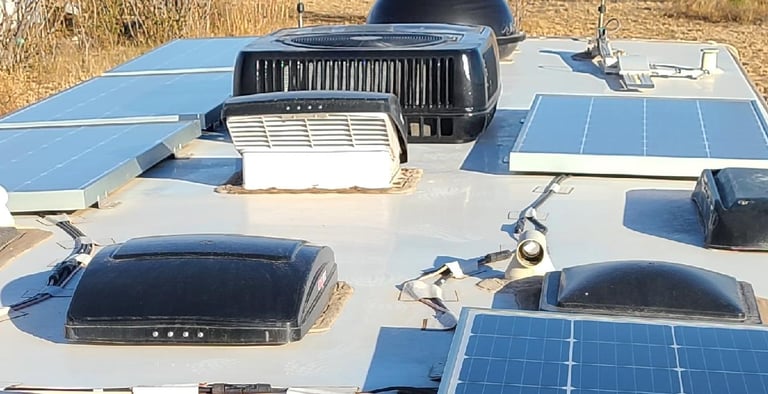

Our solar power system has always been overwhelming to me, and Tom has explained how it works to me so many times I have lost count. It has always felt intimidating and electricity has that sense of danger to it. I found that breaking it down into smaller components makes it easier to understand. Tom has stuck with it and has been teaching and helping me to know more about it. This is my understanding of how our system works.
We have eight solar panels mounted to the roof in two arrays. Arrays are groups of panels linked together. Array #1 has four panels of 210 watts each, and Array #2 has 2 panels of 210 watts each and 2 panels of 215 watts each (we added two panels later from the same company). That is a total of 1690 watts. This past fall we learned that the shorter hours of sunlight and the low angle of the sun prevented our roof-mounted arrays from keeping up. To help our system, we added a third portable array on the ground to supplement our roof system. This array has 3 portable solar suitcases with 220 watts each. In hindsight, we should have made our rooftop panels tiltable, but we were concerned that they would not be as secure doing that.
A principle of electricity is that watts = volts x amps. Fuses, breakers, and wiring are rated for amps, so for the same wattage, if you increase the volts, the amps decrease. With less amps, you have less heating of the components and can use smaller gauge wire. A great way to take advantage of this is to set up the arrays at least partially in series. When they are in series, the positive of one panel is connected to the negative of the other panel, doubling the voltage and halving the amperage. Think of it like batteries stacked in a flashlight: they are in series to take advantage of combining the volts and reducing the amps so components like springs can be thinner. Alternately, when they are in parallel, the positive is connected to the positive and the negative to the negative. Arrays 1 and 2 are connected in series-parallel, with 2 panels in series, and those two sets in parallel. Array 3 is in parallel only.
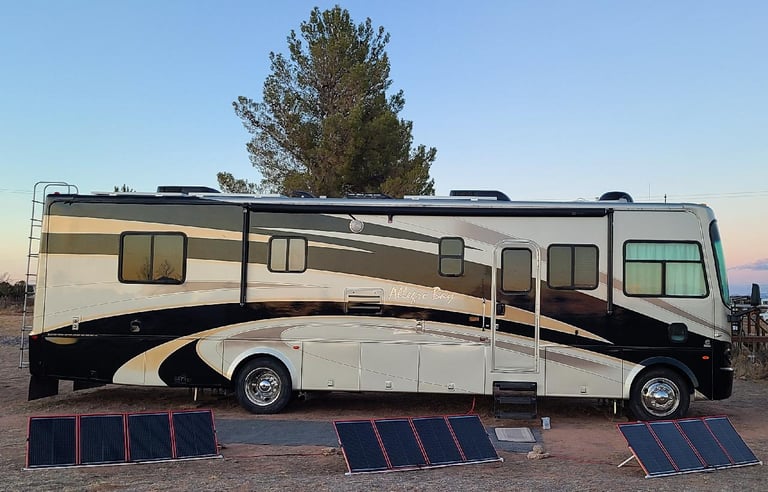

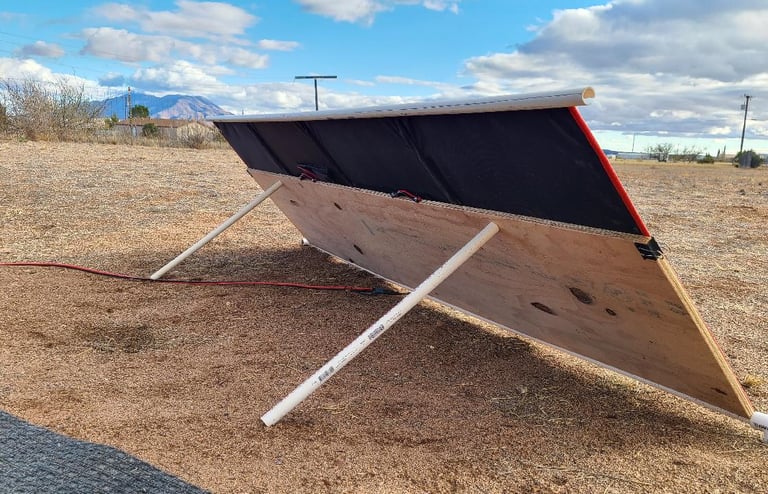

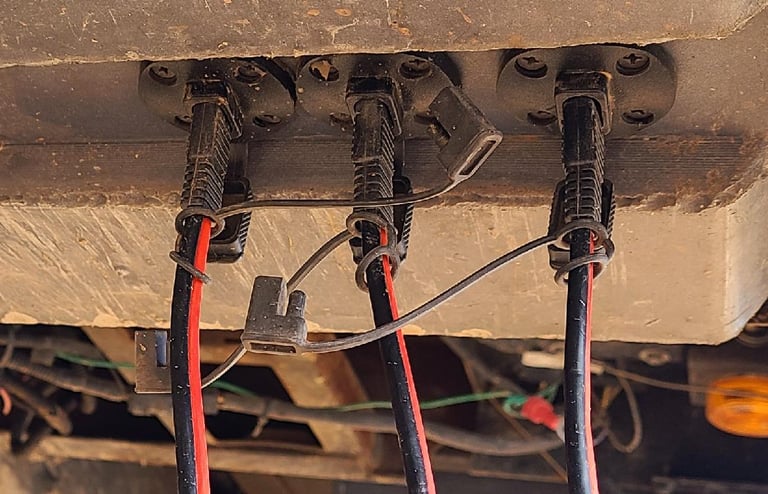

Next in line are the solar charge controllers. There are two types of controllers. Pulse Width Modulation (PWM) controllers are older technology, but still in use. Maximum Power Point Tracking (MPPT) controllers are more efficient and can convert excess voltage into more amps, resulting in more power generation from the same panels. Their function is to receive a wide range of voltage from the solar panels, stabilizing that voltage while transferring it to the batteries. The voltage received is also variable based on the how much sunlight is being received, i.e. cloudiness. Our charge controllers are the MPPT variety from Victron that each can take in up to 100 volts at 50 amps, reducing it to an appropriate 12-15 volts to be stored in our batteries if not consumed by our usage.
We have eight 12 volt/100 Amp-hour lithium (LiFePO4) batteries to store the energy we have collected through the panels. Considering they run optimally at 12.8 volts, they each have the ability to store 1280 watt-hours of power. This would deplete more than one whole battery in that timeframe. They are temperature sensitive and can operate within a range of -4°F to 140°F (-20°C to 60°C), but optimal performance is achieved between 32°F and 113°F (0°C and 45°C). Lithium batteries should not be charged outside of the optimal range or the cells will be damaged and the battery will fail prematurely. Our batteries have a mini computer inside called a Battery Monitoring System (BMS) that prevents the battery from taking a charge if it is outside of that range. Each battery can put out 100 amps, and since they are bridged, they can put out 800 amps total, which is 9600 watts!!! Appliances, like the air conditioning, which are rated at 1500 watts, will consume 1500 watt-hours if ran for one hour. We may run one air conditioner for a short period before bed to cool things off, and if temps are too high for comfort, it’s better to check into a campground and benefit from their electricity.
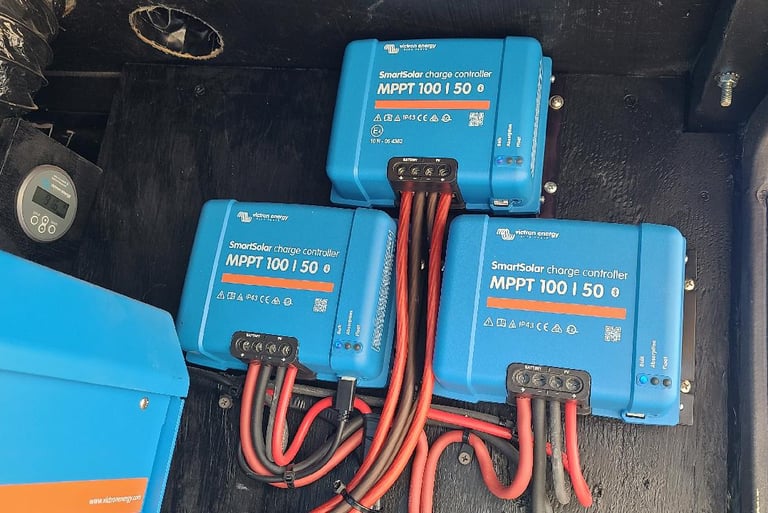

We have eight 12 volt/100 Amp-hour lithium (LiFePO4) batteries to store the energy we have collected through the panels. Considering they run optimally at 12.8 volts, they each have the ability to store 1280 watt-hours of power. This would deplete more than one whole battery in that timeframe. They are temperature sensitive and can operate within a range of -4°F to 140°F (-20°C to 60°C), but optimal performance is achieved between 32°F and 113°F (0°C and 45°C). Lithium batteries should not be charged outside of the optimal range or the cells will be damaged and the battery will fail prematurely. Our batteries have a mini computer inside called a Battery Monitoring System (BMS) that prevents the battery from taking a charge if it is outside of that range. Each battery can put out 100 amps, and since they are bridged, they can put out 800 amps total, which is 9600 watts!!! Appliances, like the air conditioning, which are rated at 1500 watts, will consume 1500 watt-hours if ran for one hour. We may run one air conditioner for a short period before bed to cool things off, and if temps are too high for comfort, it’s better to check into a campground and benefit from their electricity.
Our system operates the motorhome electrical systems through two Victron Multiplus inverter/chargers. The inverter changes the energy stored in the batteries from 12 volts to 120 volts for use at the outlets and appliances. When there is more power coming in from the shore connection or generator, the charger converts that power from 120 volts to 12 volts and sends it to the batteries. They have a feature that allows us to limit the amount of shore power that we are bringing in. It can be set anywhere from 7.7 to 50 amps per inverter/charger, depending on what is available. If we are connected to a 15-amp outlet on the outside of someone’s house, we set it at 7.7 amps on one and the other zero so that we do not damage their wiring or outlet. If we know we will using something like the water heater, we will increase the amps on that inverter and set the other to zero, so that the energy does not have to be converted between the 12 volt and the 120 volt systems. The inverter/chargers can put out 2400watts continuously, or 3000 watts peak when we are not connected to shore power. They can also assist from the batteries to make up the difference if the motorhome is plugged into a 15-amp shore power outlet.
The system also has a Battery Monitor, that tells us the percentage of charge that is remaining in the batteries once the system has gone through a full charge cycle to 100%.
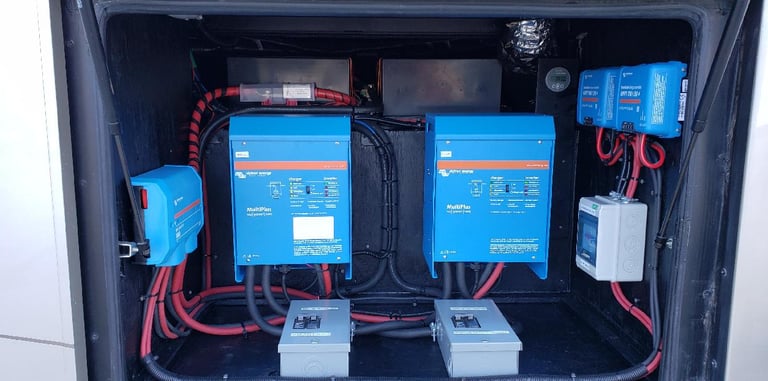

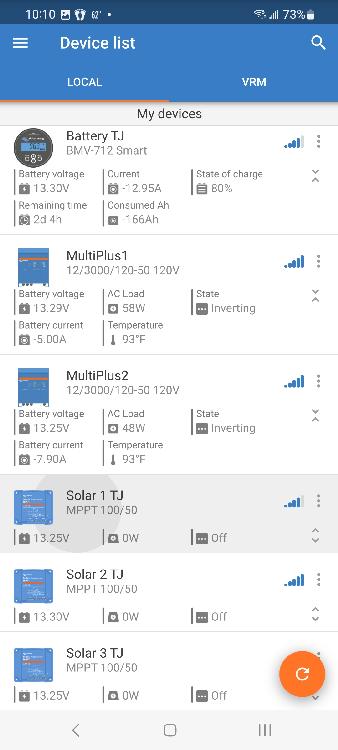

We have an app on our phones that helps monitor the different parts of the system. It is great to check and see how much power we are generating or using. It also has options to adjust the amount of amps that are allowed in and to turn the inverters off and on.
We have learned how to manage our power supply efficiently when needed. In the summer, when the sunlight is plentiful, we often use power earlier in the day to bake or precook things that we can reheat later in the evenings. This gives the system time to recover before darkness sets in. Long periods of cloudiness or rain leaves us with little solar power, but we do have a 5500-watt on-board diesel generator that we have sparingly used to maintain the power in our batteries. When we use the generator to recharge the batteries, we also make sure we are doing something like cooking, baking, or turning on the water heater. This helps capture all the energy from the generator, since it puts out more power than the inverter/chargers can send to the batteries. We don’t use the generator much, and have put less than 40 hours on it since we bought the RV two years ago!
We almost never use propane in our daily routine. We have used it in the winter for the furnace and the water heater, since the solar power is more limited. We have a propane stove, but have not used it since we bought an induction cooktop. We replaced the old absorption fridge with one that only runs on DC power from the batteries.
We have noticed that elevation makes a difference in how much power we receive. The higher the elevation, the less atmosphere there is to filter out the UV rays, so the higher we go the more power we get.
Putting in the solar system was not cheap, but it affords us the opportunity to stay in places without services, while enjoying the peace & quiet without a noisy generator. We have spent relatively little money on campgrounds since going out on the road fulltime. Compound that year with another, and the savings in lodging will pay for the entire system. Our solar system might look complicated, but if I break it down, it is much easier to understand and remember. I don’t know why I was so intimidated to learn more about it sooner.
Share your comments on Facebook or email us at roadfronts@gmail.com
Subscribe for monthly updates
Current location:
